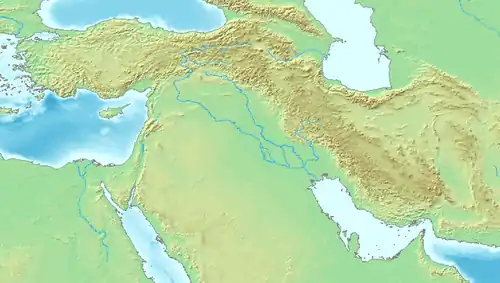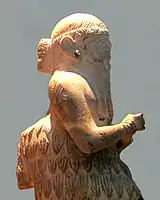Ishqi-Mari
Ishqi-Mari or Ishgi-Mari (𒅖𒄄𒈠𒌷 iš11-gi4-ma-rí),[5] previously read Lamgi-Mari,[6][1] was a King of the second Mariote kingdom who reigned c. 2350-2330 BCE. He is one of three Mari kings known from archaeology, Ikun-Shamash probably being the oldest one.[7] The third king is Iku-Shamagan, also known from an inscribed statue.
| Ishqi-Mari 𒅖𒄄𒈠𒌷 | |
|---|---|
| King of Mari | |
.jpg.webp) Statue of Ishqi-Mari,[1] Aleppo National Museum. Here seen at an exhibition in the Institut du Monde Arabe, Paris in 2014.[2][3][4] | |
| Reign | c. 2350-2330 BCE Middle Chronology |
| King of Mari | |

In their inscriptions, these Mari kings used a dialect of the Akkadian language, whereas their Sumerian contemporaries to the south used the Sumerian language.[7]
It is thought that Ishqi-Mari was the last king of Mari before the conquest and the destruction of Mari by the Akkadian Empire under Sargon circa 2330 BCE.[8]
Inscriptions
Ishqi-Mari is known from a statue with inscription.[7] The statue is in the Aleppo National Museum.[1][9][10] The inscription on the back of the statue reads:
𒅖𒄄𒈠𒌷 / 𒈗𒈠𒌷 / 𒑐𒋼𒋛𒃲 / 𒀭𒂗𒆤 / 𒊨𒋤 / 𒀀𒈾 / 𒀭𒈹𒀴 / 𒊕𒄸𒁺ish11-gi4-ma-ri2 / lugal ma-ri2 / ensi2 gal / Den-lil2 / dul3-su3 / a-na / Dinanna-nita / sa12-rig9
"Ishqi-Mari, king of Mari, great ensi of Enlil, dedicated his statue to Inanna"
This inscription was instrumental in identifying Tell Hariri with the Mari of antiquity.[13]
Several cylinder seals with intricate designs in the name of "Ishqi-Mari, King of Mari" are also known.[14]
Discovery (23 January 1934)

The statue of Ishqi-Mari was discovered buried in the archaeological remains of the ancient city of Mari, in the Temple of Ishtar, by a French archaeological team led by André Parrot on 23 January 1934.[15][16]
The statue shows Ishqi-Mari with a long beard and parted and plaited hair. He wears a hairbun similar to the Sumerian royal hairbuns, such as on the headdress of Meskalamdug or reliefs on Eannatum.[1][17] He wears a fringed coat leaving one shoulder bare, a type of clothing also seen on contemporary Akkadian Empire depictions of rulers.[15]
.jpg.webp) Ishqi-Mari statue (front)
Ishqi-Mari statue (front).jpg.webp) Ishqi-Mari statue (side)
Ishqi-Mari statue (side).jpg.webp) Ishqi-Mari statue (back)
Ishqi-Mari statue (back)
In Aleppo museum
 Ishqi-Mari in profile. He wears a hairbun similar the Sumerian royal hairbuns, such as on the headdress of Meskalamdug or reliefs on Eannatum. The inscription is visible on the back of the right shoulder.[1]
Ishqi-Mari in profile. He wears a hairbun similar the Sumerian royal hairbuns, such as on the headdress of Meskalamdug or reliefs on Eannatum. The inscription is visible on the back of the right shoulder.[1].jpg.webp) Statues from Mari. The statue of Ishqi-Mari appears partially on the left: it is much smaller than many of the traditional Mari statues.[1] Aleppo National Museum
Statues from Mari. The statue of Ishqi-Mari appears partially on the left: it is much smaller than many of the traditional Mari statues.[1] Aleppo National Museum%252C_Aleppo_National_Museum%252C_Syria.jpg.webp) Ishqi-Mari (forefront, in profile), before larger figures.[1]
Ishqi-Mari (forefront, in profile), before larger figures.[1]
King Ishqi-Mari of Mari | ||
| Regnal titles | ||
|---|---|---|
| Preceded by Hidar |
King of Mari 2350-2330 BCE |
Succeeded by (Akkadian Empire) |
References
| Wikimedia Commons has media related to Ishqi-Mari. |
- Art of the First Cities: The Third Millennium B.C. from the Mediterranean to the Indus. Metropolitan Museum of Art. 2003. p. 148. ISBN 978-1-58839-043-1.
- "Voués à Ishtar". Institut du monde arabe (in French). 19 July 2016.
- Complete views of the statue upon discovery: Parrot, André (1935). Les fouilles de Mari (Première campagne). p. Plate VII.
- "Voués à Ishtar. Syrie, janvier 1934: André Parrot découvre Mari (2014 exhibit)" (PDF).
- Beyer, Dominique (18 December 2018). "Les sceaux de Mari au IIIe millénaire : Observations sur la documentation ancienne et les données nouvelles des villes I et II". Akh Purattim 1 (in French). MOM Éditions. pp. 231–260.
- 𒇴𒄄𒈠𒌷
- Spycket, Agnès (1981). Handbuch der Orientalistik (in French). BRILL. p. 86. ISBN 978-90-04-06248-1.
- Eppihimer, Melissa (2019). Exemplars of Kingship: Art, Tradition, and the Legacy of the Akkadians. Oxford University Press. p. 147. ISBN 978-0-19-090302-2.
- Spycket, Agnès (1981). Handbuch der Orientalistik (in French). BRILL. p. 88. ISBN 978-90-04-06248-1.
- Alfred Haldar (1971). Who Were the Amorites. p. 16.
- "CDLI-Archival View". cdli.ucla.edu.
- For a clear picture of the inscription: "Images of Ishqi-Mari".
- Leick, Gwendolyn (2002). Who's Who in the Ancient Near East. Routledge. p. 168. ISBN 978-1-134-78796-8.
- Seal impression 1, Seal impression 2 in Beyer, Dominique (18 December 2018). "Les sceaux de Mari au IIIe millénaire : Observations sur la documentation ancienne et les données nouvelles des villes I et II". Akh Purattim 1 (in French). MOM Éditions. pp. 231–260.
- Leick, Gwendolyn (2002). Who's Who in the Ancient Near East. Routledge. p. 81. ISBN 978-1-134-78796-8.
- Parrot, André (1935). "Les fouilles de Mari. Première campagne (hiver 1933-34). Rapport préliminaire". Syria. 16 (1): 1–28. doi:10.3406/syria.1935.8338. ISSN 0039-7946. JSTOR 4389879.
- McKeon, John F. X. (1970). "An Akkadian Victory Stele". Boston Museum Bulletin. 68 (354): 237. ISSN 0006-7997. JSTOR 4171539.
.jpg.webp)
